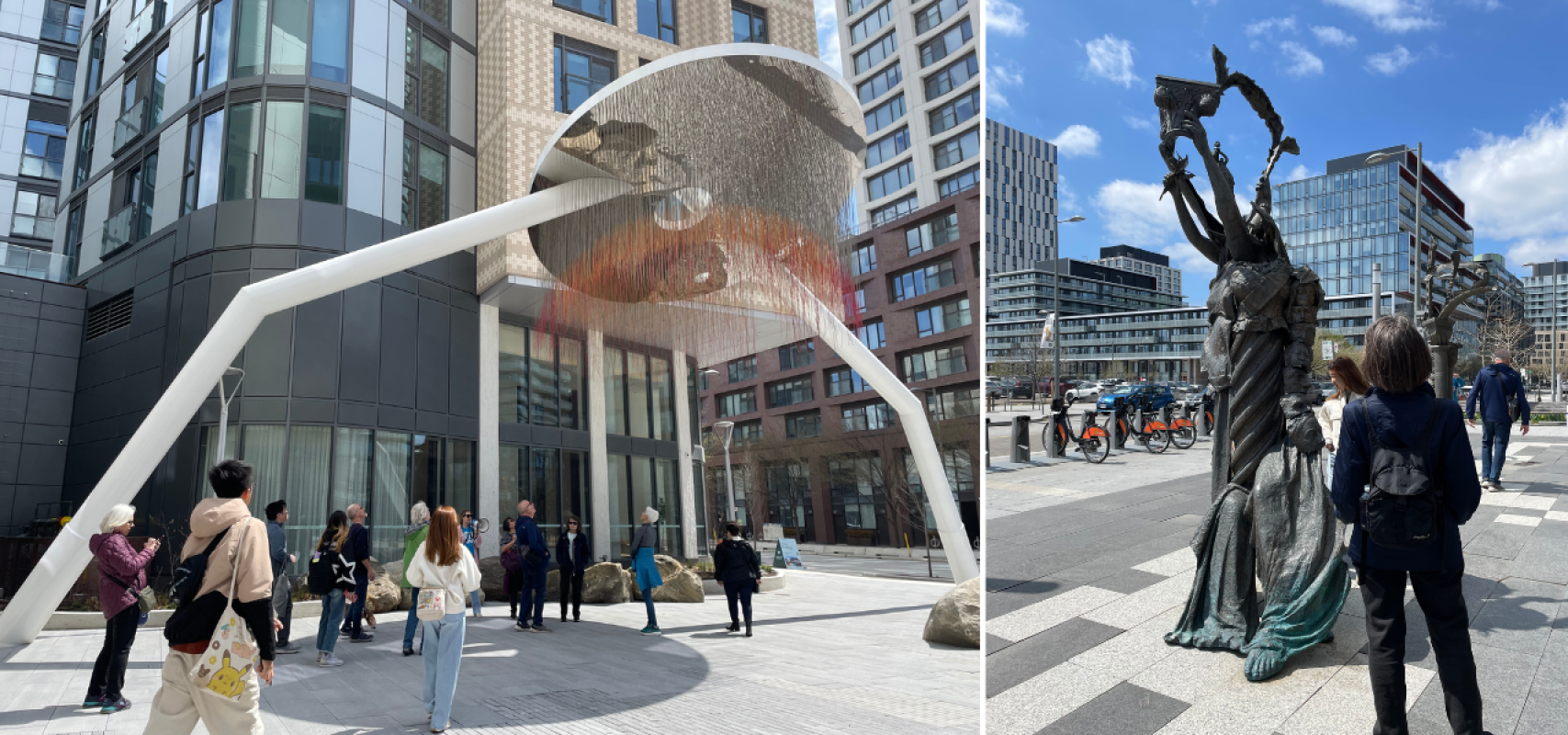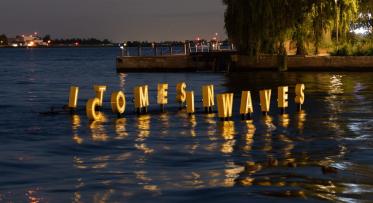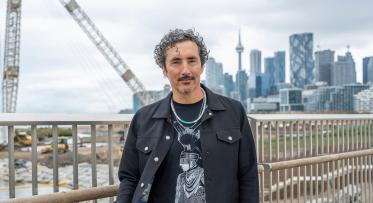A Virtual Tour of Public Art in the West Don Lands
PUBLISHED: JULY 4, 2025
In This Blog:
- Waterfront Toronto’s integrated public art strategy transformed the West Don Lands into a living gallery in the heart of Toronto downtown.
- Public art was embedded into the West Don Lands' design from the start — shaping streetscapes, parks, and gathering places.
- West Don Lands is now a vibrant neighbourhood with eight striking artworks that reflect the area’s layered history, from Indigenous roots to industrial past.
- The artists who worked on West Don Lands’ public art have used playful, reflective, and site-specific approaches to foster connection, curiosity, and civic storytelling.
The West Don Lands neighbourhood stands as a shining example of how thoughtful urban planning and design can create a complete community. At the heart of this transformation is public art — a vital component that shapes how people connect with their neighbourhood, their history, and each other.
From the outset, Waterfront Toronto ensured public art was embedded into the vision for the West Don Lands not as an embellishment, but as a powerful tool to animate public spaces, reflect cultural values, and encourage civic dialogue. The neighbourhood is home to the first community scale Public Art Strategy in Canada, offering a cohesive collection of unique installations woven into streetscapes, parks, and gathering places. This forward-thinking approach ensured that artists had a meaningful role in shaping the community's identity from the ground up.
In line with the 2005 West Don Lands Precinct Plan, the public realm here was always intended to be more than functional – it was envisioned as a dynamic, expressive, and memorable environment. By commissioning artworks that resonate with the site’s layered histories, from Indigenous presence to industrial past, and its future as a thriving, mixed-use community, Waterfront Toronto has created a living gallery where everyday life and contemporary art intersect.
In this virtual tour, we invite you to explore the public art in the West Don Lands. Each piece tells a story of people, of place, and of the evolving spirit of this remarkable neighbourhood.
The Water Guardians, by Jennifer Marman and Daniel Borins with James Khamsi (Front Street Promenade, Front Street East and Tannery Road Intersection)

Marc Mayer, former Director of the National Gallery of Canada, once noted Marman and Borins as “young artists to watch”. Well, Waterfront Toronto listened, and it was a pleasure working with the artists in realizing this project for the West Don Lands. The challenge with this site was to create work that would engage children. Marman and Borins with Khamsi thoughtfully integrated art, landscape and play in a concept that is both serious and whimsical, and as a result, the Water Guardians were born.
With bouncy ground plane, variegated topography and graphic form and colour, the artwork’s aesthetic speaks readily to children in a playful way. But the title and watchful eyes denote a more serious regard for children, who need guardians, but are also guardians of the future. The artwork acts as a bridge between the nearby man-made water feature and the real Don River that flows beyond the end of Front Street, while the absence of actual water hints at a natural resource to be protected and appreciated.
Untitled (Toronto Lamp Posts), by Tadashi Kawamata (Front Street Promenade, Front Street East and Rolling Mills Road Intersection)

Tadashi Kawamata is based in Paris and internationally celebrated, but is no stranger to Toronto having shown a couple of grand scale temporary pieces here over the years. You may have seen Garden Tower as part of Nuit Blanche in 2013, or you may even remember his installation at Colonial Tavern Park on Yonge Street opposite the Eaton Centre, Toronto Project 1989, commissioned by Mercer Union – his first permanent commission in Toronto.
Toronto Lamp Posts create an iconic visual landmark for this area. The work applies the artist’s international art practice in a concept that is unique to Toronto and the industrial heritage of the West Don Lands area. Over the decades and across the map, Toronto’s city of neighbourhoods, has donned lamp posts in a wide variety of styles, materials and heights that have come to characterize eras and areas. To make this piece, a selection of lamp posts was sourced from various yards and depots and the artist worked in an organic way, selecting on the spot which post would go where, to create the effect he intended. The result is wonderful: having the appearance of Mikado sticks just before they fall, the formal bundling together of this jumble of city infrastructure collapses history and geography into one playful gesture.
Peeled Pavement, by Jill Anholt (Mill Street, west of Bayview Avenue)
Peeled Pavement was developed by Vancouver-based artist Jill Anholt, through collaboration with the Planning Partnership, as an integrated feature of the public realm design for Mill Street. Installed along Mill Street, which connects the Distillery District to Corktown Common, Peeled Pavement punctuates the sidewalk with a series of tears in the urban fabric, curling up to reveal an underside of industrial artifacts cast in bronze and, in their absence, swathes of glowing light, the energies of the working city. Exposing the layers and systems of the site, the piece links history to the renewal of life in the present and growth envisioned for the public realm of the future.
No Shoes, by Mark di Suvero (Bayview Avenue and Mill Street Intersection)
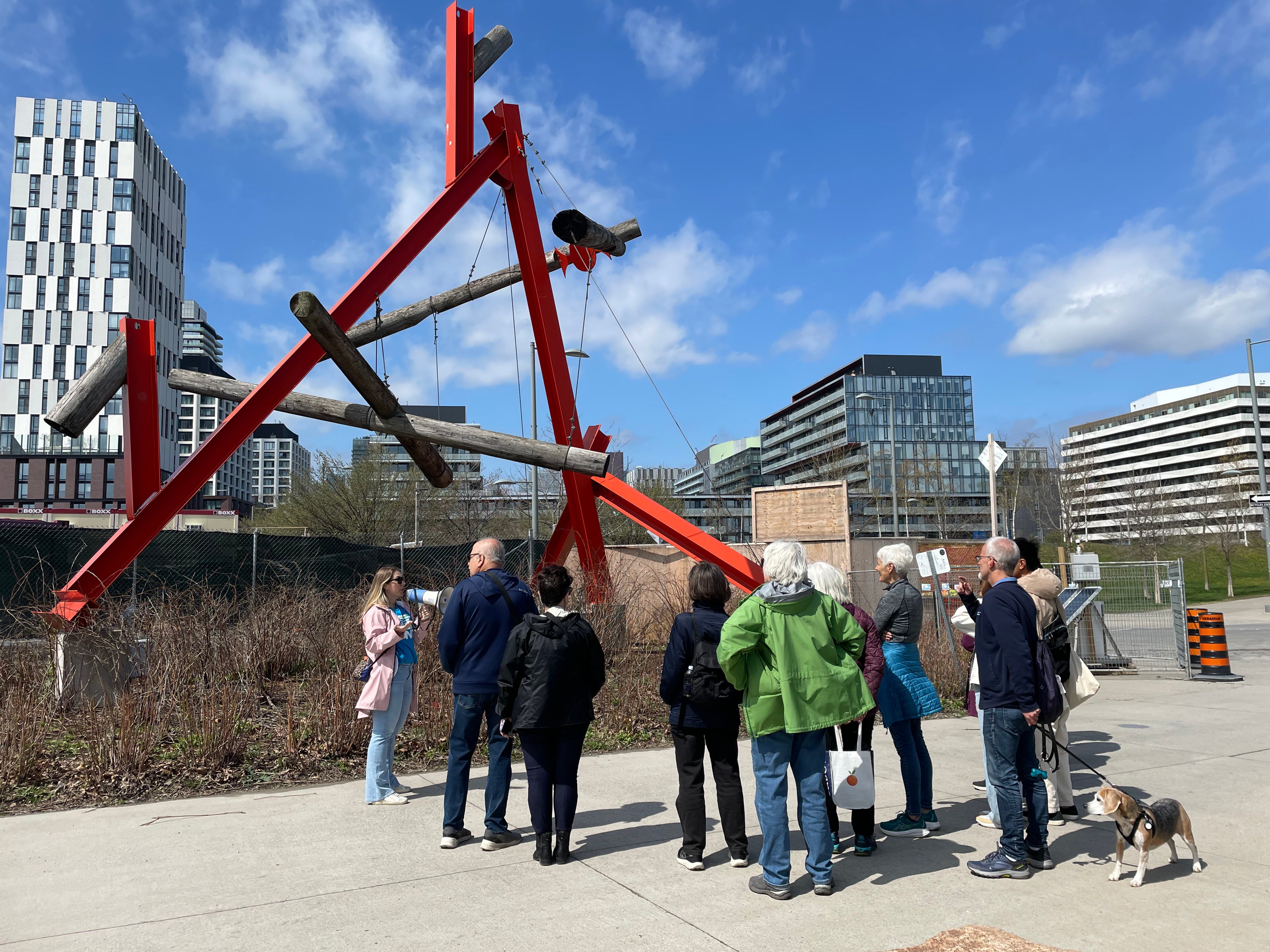
Mark di Suvero is internationally considered to be one of the most significant sculptors of the 20th century and we were thrilled to include an important early work of his in our West Don Lands program. In 1967, while in the early stages of his career, di Suvero was invited by the City of Toronto to participate in an International Sculpture Symposium in High Park.
Di Suvero was given access to a crane and operator and the results were two monumental pieces, Flower Power and No Shoes, which were the first works in what became the artist’s signature style. The title and appearance of effortless symmetry are expressions of the optimism of the 1960s. This optimism resonates with the revitalization and future neighbourhood, while the materials of the sculpture speak to the natural and industrial history of the area. After a lengthy restoration and re-installation coordinated with the City of Toronto, who continue to own the work, and overseen by di Suvero himself, No Shoes was installed in Corktown Common in 2013, the same year that di Suvero was awarded the prestigious Gold Medal from the American Academy of Arts and Letters.
Site Specific, by Scott Eunson and Marianne Lovink (Sumach Street and Eastern Avenue Intersection)
If you’ve been by the intersection of Sumach and Eastern, you’ve likely noticed the Site Specific artwork by Toronto and Philidelphia–based artist team Scott Eunson and Marianne Lovink.
Site Specific, with a mission to link the West Don lands to Corktown, uses the 40-meter-long linear site (which actually functions as a retaining wall to deal with a grade change as well as a fence for the adjacent school) to portray in abstract pattern and form, a deep history of human existence in the immediate area, with an expanded focus on the era of Thornton and Lucie Blackburn whose home was on the site of the adjacent Inglenook Secondary School. The Blackburns were escaped slaves who came to Canada through the Underground Railroad and assisted many more escaped slaves in getting safely into Canada.
The artists worked with historian Karolyn Smart Frost and the students at the school in the making of the artwork. Site Specific is an artist's abstract musing on the human stories that make a place. This piece is truly spectacular at dusk, when an LED track between the CorTen and stainless panels is lit, and it looks like it is on fire.
Mirage, by Paul Raff (29 Lower River Street)
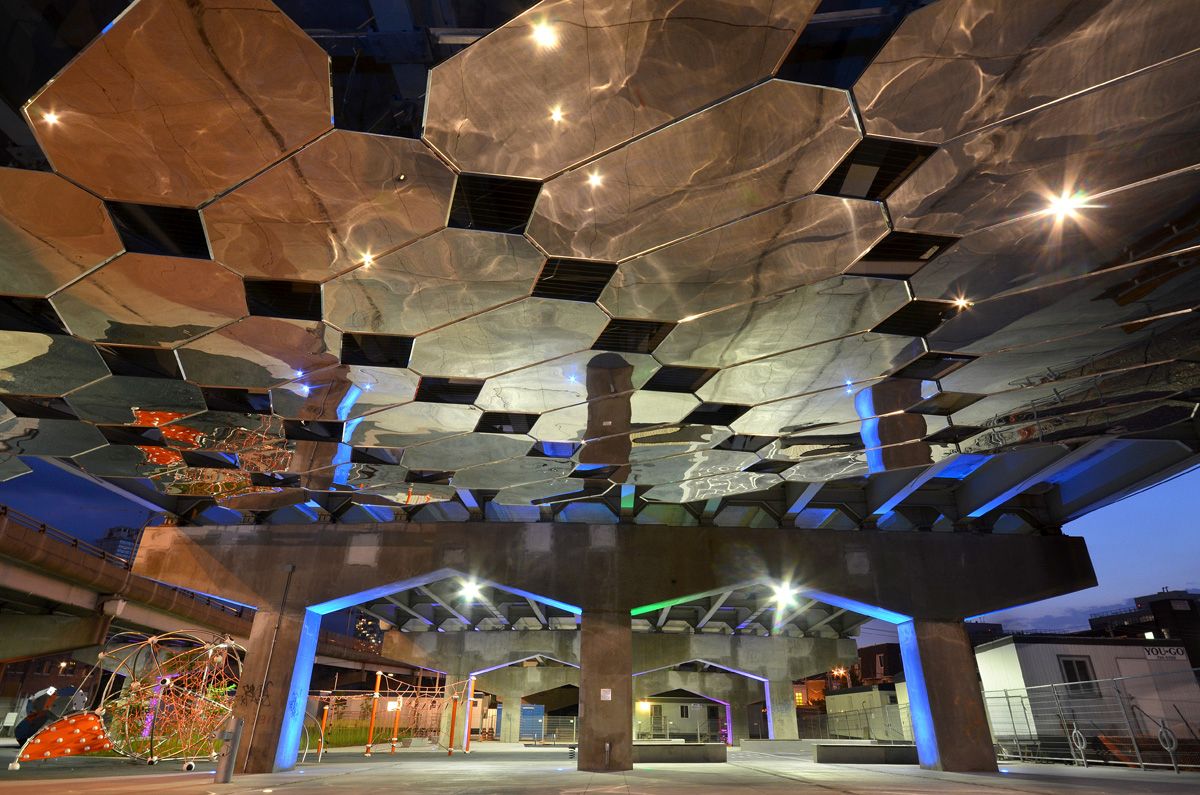
Unveiled in 2012 in Underpass Park, Mirage, by Toronto-based artist Paul Raff, takes inspiration from the fact that this is a park with a ceiling (a unique condition for a park) and creates a dynamic space that would invite movement across it. The installation of 57 octagonal mirror polished stainless steel surfaces applied to the underside of the Richmond/Adelaide/Eastern overpass draws inspiration from the definition of a mirage as an optical illusion created by atmospheric conditions. The artist used very heavy industrial materials to recreate a very ephemeral natural optical illusion that blurs the horizon line between earth and sky. Each of the panels is slightly different in size and spacing to create a subtle sense of movement as their mirror-polished surfaces bounce light around the space.
Note, the City of Toronto is currently rehabilitating the Richmond/Adelaide/Eastern overpass leading to the closure of portions of Underpass Park during construction to ensure the safety of park users and to provide the Contractor access to the required work area. As a result, in May 2024, Mirage was temporarily removed and safely stored. The artwork will be reinstalled once the construction is completed. Visit the City of Toronto website for more information.
Garden of Future Follies, by Hadley + Maxwell (Front Street Promenade, Bayview Avenue and Front Street East Intersection)
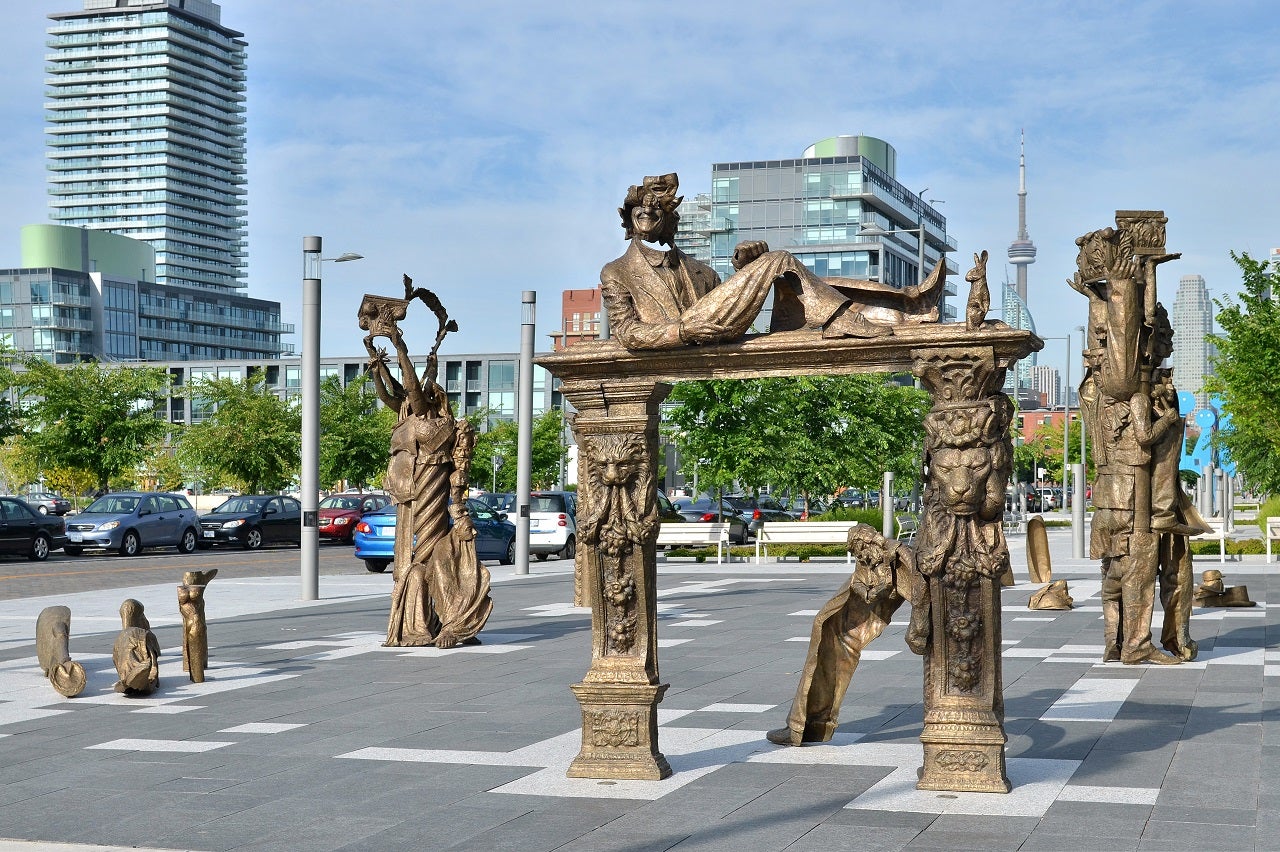
With substantial international exhibition history under their belt, artist duo Hadley + Maxwell (Hadley Howes and Maxwell Stephens) created their first permanent public artwork, which anchors a key social space in the neighbourhood. Garden of Future Follies brings the past to life by fragmenting and rearranging parts of monuments, sculptures and architecture from all over Toronto. Based on the idea of the folly, a fanciful and purely decorative structure popular in 18th and 19th century romantic gardens and landscapes, this project reimagines a ‘garden of follies’ incorporating elements from monuments that are normally high above the street and physically out of reach, bringing them down to street level where they can be celebrated and enjoyed. The work builds a collection of unusual characters that create a sense of play, inviting us to explore and interact with our city’s history.
The sculptures were created using a “cinefoil” process, which uses a thick aluminum foil material pressed against an object to take its shape. The aluminum impression is then used to create a mold and cast a bronze version of the original. For the artists, this means an opportunity to re-envision how parts of an existing work can create a completely new sculpture; these fragments are then reassembled by the artists to form a new and imaginative cast of characters, named for archetypes found within the tradition of monument. With this public artwork, Hadley and Maxwell tackled the idea of the monument and asked us to question the way we think about public art.
In Equilibrium, by Ludovic Boney (Anishnawbe Health Toronto, Cherry Street and Mill Street Intersection)

In Equilibrium was created by Ludovic Boney, a sculptor and artist from Wendake, Quebec and part of the Wendat First Nation. It stands nearly 28 feet high and acts as a gateway into the Anishnawbe Health Toronto health centre and Indigenous Hub — one of the first mixed-use, purpose-built Indigenous Hubs in the country and the first in Ontario. The installation creates an instantly recognizable landmark for this important new facility, while celebrating Indigenous placemaking and placekeeping and the layers of Indigenous presence — past, present and future — in Toronto.
The piece features thousands of fire-coloured hanging stems, which evoke a natural landscape with a nod to cattails and reeds. They hang under a mirrored surface, with a view of the sky. When you stand beneath and look up, instead of the sky, you will see your own world reflected to you, encouraging contemplation about how you fit into the surrounding landscape. The piece rekindles relationships to land, not just for Indigenous peoples, but for all the diverse people who call Toronto home. Through this act of introspection, the work promotes hope and healing. This monumental new artwork highlights the contributions of contemporary Indigenous art and culture in Toronto.
Our Permanent Public Art Program
During the precinct planning process, we create a public art strategy and select locations for permanent public artwork in each waterfront district. Once complete, each artwork becomes part of the City of Toronto’s Public Art and Monuments Collection. To learn more about Waterfront Toronto’s public art program, please visit our website.
If you’d like to stay up to date about what's happening on Toronto’s waterfront sign up for our Monthly Newsletter!

